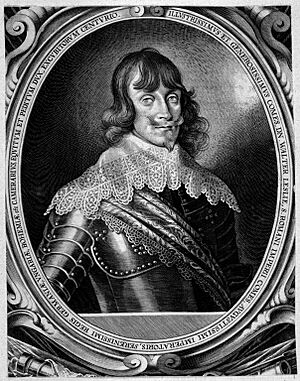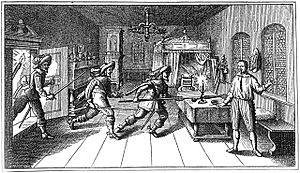Walter Leslie (field marshal) facts for kids
Count Walter Leslie (born in Fetternear House, Aberdeenshire, Scotland, in 1607 – died in Vienna, Austria, on March 4, 1667) was a Scottish soldier and diplomat. He became a very important person in the Holy Roman Empire. He reached high ranks like Imperial Field Marshal, which is a top military leader. He was also made a Count of the Holy Roman Empire. Walter Leslie served as Governor of the Croatian Military Frontier, and as an Imperial Ambassador to places like Naples, Rome, and Constantinople.
Contents
Walter Leslie's Family Life
Walter Leslie came from an important Scottish noble family called the Clan Leslie. His father, William, was the 10th Baron of Balquhain. His mother, Joan, was the daughter of John Baron of Gogar.
In 1647, Walter Leslie married Anna Francesca von Dietrichstein. She was the daughter of Count Maximilian von Dietrichstein. Walter and Anna did not have any children. His nephew, Count James Leslie, took over his titles and family castle, Nové Město nad Metují, after Walter died.
Early Military Career
In 1624, Walter Leslie traveled across the North Sea to join the Protestant Army of the United Provinces. By 1628, he was fighting in Stralsund, Germany, possibly for the Danes or the Swedes.
In 1630, he switched to the army of the Catholic Holy Roman Emperor. That summer, he fought alongside another Scottish soldier, John Gordon, in the War of the Mantuan Succession in Italy. In 1631, the army was called back from Italy. By December 1631, Leslie was in Northern Germany, fighting under General Albrecht von Wallenstein against the Swedes.
By July 1632, Leslie had become an oberwachtmeister, which is like a sergeant in the infantry. He served under Count Adam Erdmann Trčka von Lípa, who was Wallenstein's brother-in-law. John Gordon was Leslie's lieutenant colonel. Leslie and Gordon became very close to Wallenstein. Leslie fought under Gordon in battles at Bentheim and Freistadt. At Freistadt, both men were captured by the Swedes. They had been in charge of 1,000 Scottish and Irish musketeers. After this, Gordon became a regiment commander, and Leslie became his spokesperson in court. This was an important step for Leslie. In November 1632, Leslie fought with Gordon at the Battle of Lützen. The Protestants won this battle, but the Swedish king, Gustavus Adolphus of Sweden, was killed. After the battle, they were stationed at Eger, and Leslie was again Gordon's second-in-command.
The Plan to Remove Wallenstein
In December 1633, some Italian Imperial generals started planning to remove Wallenstein from his powerful position. During this time, Leslie, Gordon, and Irish Colonel Walter Butler were still working for Wallenstein. However, they also began talking with the Italian generals. Leslie wrote to one general, promising his loyalty to Emperor Ferdinand II. He also asked for a promotion for his service to the emperor.
This letter was sent just before Wallenstein's officers signed an agreement to stay loyal to him. Leslie never signed that agreement. Days later, the Italian generals and 18 other senior officers signed a document. This document showed they no longer trusted Wallenstein. By January 1634, Leslie and Gordon had joined forces with one of the Italian generals. This general had just been made a field marshal. Leslie and Gordon were preparing their soldiers in Eger. In January 1634, Emperor Ferdinand II secretly ordered Wallenstein's arrest. Wallenstein then tried to find out if his Scottish officers, Gordon and Leslie, were still loyal. He offered Gordon a promotion and asked to meet with Leslie.
When Butler brought Wallenstein into Eger, Leslie and Gordon were waiting inside the castle. There are different stories about what happened in late February, but some details are always the same. On February 24, Wallenstein arrived in Eger and went to bed at the Burgomaster's house, which was outside the castle walls. That night, Leslie, Butler, and Gordon had dinner. They finalized their plan to remove Wallenstein and his main officers. After dinner, a messenger came for Wallenstein. Leslie took the messenger to the general's room. The letter was from Emperor Ferdinand II. It officially removed Wallenstein as a general and called him a traitor. Wallenstein reportedly shared his frustrations with Leslie. He even told Leslie about his plans to join forces with Saxe-Weimar.
The next morning, Leslie, Butler, and Gordon swore an oath with one of Wallenstein's loyal officers, Ilow. They promised to remain loyal to Wallenstein. Later that day, the Scottish officers invited all the loyal officers to a special dinner to celebrate Wallenstein. Adam Trčka, Vilem Kinsky, Christian von Ilow, and a lower-ranking officer named Niemann attended. Wallenstein did not come because he was ill. At the dinner, they made toasts to Wallenstein. They also complained about the court in Vienna.
Reports of what happened next differ slightly. However, everyone agrees that at the end of dinner, Leslie, Butler, and Gordon stood up. They drew their swords and shouted something like, "Long live Ferdinand and the House of Austria!" At that moment, the drawbridge was raised, and Irish soldiers entered the dining hall. Leslie was wounded during the fight, but all of Wallenstein's officers were killed. Next, Leslie left the castle walls to get Walter Devereux and a team. They went to Wallenstein's room, where he was sleeping, and removed him from power.
Leslie was the first to bring the news to Vienna. Because of this, the Emperor heard his name first. Emperor Ferdinand II rewarded Leslie and his friends very generously for their actions. Leslie received Trčka's castle, Nové Město nad Metují, and other properties. He also received the "golden chain" from the emperor. As a result of these events, Leslie's career as a military officer, politician, and diplomat grew very quickly.
Imperial Court and New Roles
In 1634, Emperor Ferdinand II made Leslie an imperial chamberlain. This was an important position in the royal household. His military rank was increased to lieutenant field marshal. He also became the head of the bodyguard for the King of Hungary. He was given command of two regiments of soldiers.
Soon after these promotions, in the summer of 1634, he helped in the successful siege of Regensburg. In September 1634, he fought in the imperial victory at the Battle of Nordlingen. In the months leading up to the Peace of Prague, Leslie was in Rathenow in Brandenburg. Historians say that among all those involved in Wallenstein's removal, Leslie was rewarded the most. His career benefited greatly from that event.
In September 1636, Leslie and the imperial forces were defeated by the Swedes at the Battle of Wittstock. In 1637, Leslie wrote to the dying Emperor Ferdinand II. He argued that his family had connections to the Habsburg royal family for over 50 years. After Ferdinand II died, Emperor Ferdinand III approved Leslie's request. He made Leslie an Imperial Count. This new title brought him a new way of life, more political respect, and more chances for diplomatic work.
Leslie served as a go-between for the Stuart and Habsburg families at a meeting in Ratisbon (1636–43). He was also an Imperial envoy to the Spanish Netherlands in 1639. He made diplomatic trips to the Caroline Court in Spain. He was a delegate in Regensburg in 1640. In 1645, he became the ambassador to Naples. In 1645, Leslie, as Imperial Ambassador to Naples, traveled around Italy. He tried to get money to help fight the war. He reportedly gave Pope Innocent X a solid silver writing table. However, the trip brought in little money and few troops.
Later Years and Diplomacy
In 1650, Leslie was made a Field Marshal and the Governor of the Croatian-Slavonian Military Frontier. This job focused his attention on the southern parts of the Holy Roman Empire. During this time, his life became more relaxed. In the 1650s, Leslie renovated his castles, Nové Město nad Metují in the Kingdom of Bohemia and Ptuj in Slovenia. He also continued his hobby of collecting and ordering works of art, especially portraits. He ordered portraits of Ferdinand II, Ferdinand III, Leopold I, and most of their families.
In 1657, he became the Vice-President of the Imperial War Council. He had also been an adviser to the Imperial Privy Council for several years. In 1663, he left his estates and titles to his nephew, James Leslie, in his will. In 1665, Walter was made a Knight in the Order of the Golden Fleece. This is a very important award.
Soon after, he went on his last diplomatic journey. He was the Imperial Ambassador to Constantinople. This trip lasted from 1665 to 1666. In Istanbul, he helped with peace treaty talks with Sultan Mehmed IV.
When he returned in 1666, Leslie's health was getting worse. He died on March 3, 1667. He was buried in the Scottish Benedictine Abbey in Vienna. Leslie had actually paid for the renovation of this very church years earlier.
|



